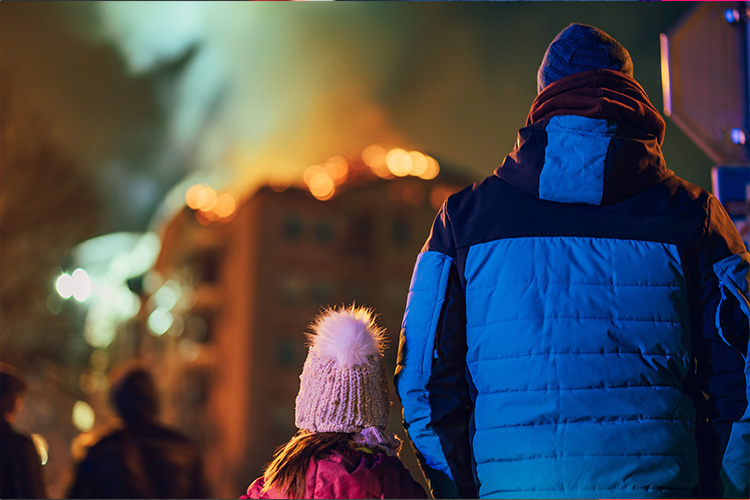Fire Safety for Parents Ensuring Children’s Winter Safety by Richard J. Blatus
As the holiday season approaches, it’s the perfect time for parents to educate their children on the importance of fire safety. Throughout my career with the Fire Department of New York, I’ve hosted countless firehouse visits welcoming children of all ages, from preschoolers to the upper elementary school grades. While such holidays are enjoyable and educational, it’s vital to recognize that the ultimate responsibility for teaching and reinforcing fire safety lies with the adults.
Recognizing that fires and related injuries are among the leading causes of death for those under the age of 14, the teaching of fire safety education to our loved ones is of paramount importance. Children often look to their parents as role models, particularly regarding safety within and around the home. While visits to the local fire company can be beneficial, reinforcing fire safety is an ongoing process that should begin at home.
To assist parents in this critical endeavor, I’ve compiled a “Top 10” list of points to empathize and review with the young members of your home.
1. Conduct Fire Drills
The importance of practice and planning cannot be overstated. Designate two exit routes from your home and practice evacuation at least twice a year. Conduct drills during both day and night hours to ensure that children are comfortable with emergency procedures at any time. Explain the importance of crawling along the floor to avoid smoke and establish a pre-designated meeting place outside the home. Ensure that babysitters are also familiar with your safety and evacuation plan.
2. Teach Children What to Expect During a Fire
Instruct children to cover their mouth and nose with a damp cloth while crawling to evacuate. Teach them to feel the door and doorknob for heat before opening, as a hot door indicates danger.
3. Once Out, Stay Out
Reiterate that once outside, no one should re-enter the home. Assure children that the family pet can get out on their own.
4. Install Smoke Alarms
Place smoke and carbon monoxide alarms on each level of your home, including the kitchen and sleeping areas. Demonstrate to your children how the alarms sound and why changing the batteries is essential twice a year.
5. Instruct Children on the Dangers of Open Flame
Candle-related fires are a significant concern, with many victims being children between 5 and 9. Emphasize the dangers of open flames and candles. Consider using battery-operated candles and reinforce that fire is a tool, not a toy.
6. Stop, Drop, and Roll
Teach children how to stop, drop, and roll if their clothing catches on fire. Emphasize the importance of stopping, not running, dropping to the ground, covering their face with their hands, and rolling until the fire is extinguished.
7. Lighters and Matches
Instruct children not to handle lighters and matches and keep them out of their reach, preferably in a locked drawer or cabinet.
8. Call 9-1-1
Ensure that children know how to call 911 or your local emergency number after evacuating from the home.
9. Flames and Heat Sources
Teach children to avoid open flames and heat sources, particularly in the kitchen.
10. Online Education
Utilize online resources like those provided by the American Red Cross and the National Fire Protection Association. These organizations offer interactive games and educational materials that can make learning about fire safety enjoyable for children.
The winter season presents unique challenges as the cold drives families to remain indoors. Spending more time inside our homes potentially increases the risk of fire-related incidents. Educating your children and incorporating the above safety tips into your daily routine can help ensure their safety and well-being.
My career as a professional firefighter has exposed me to many tragic incidents involving our youth. Children playing with matches under a bed, fires started by candles too close to combustible material, and smoke detectors with batteries removed instead of replaced. There have been too many preventable incidents that have resulted in the loss of life, which has changed the lives of families forever.
Remember that you can make a difference by sharing these valuable fire safety lessons with your children. Have a safe and joyful holiday season, knowing you are taking the steps necessary to keep your children safe! ❦
 About the Author
About the Author
Chief Blatus is a 42-year member of the FDNY, previously serving as the Acting Chief of Fire operations with direct oversight of the daily operational and administrative duties of uniformed fire personnel.
As a senior member of the agency, Chief Blatus has worked to advance strategic and operational readiness initiatives. A strong proponent of training, Rich is a published author and has lectured nationally on topics ranging from homeland security to leadership and emergency management training.
He holds a Master’s Degree in Security Studies from the Naval Postgraduate School and degrees in both Fire and Business Administration.
